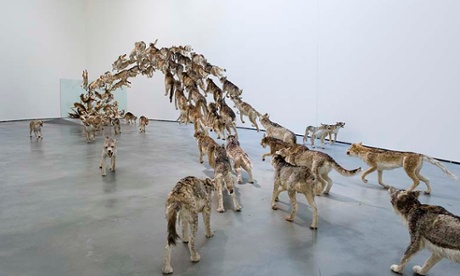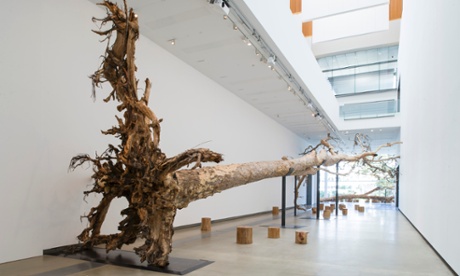We're taken into the Qagoma archives to look at an artificial kangaroo and panda, the first two parts of the highly-anticipated piece Heritage by Cai Guo-Qiang to arrive from China. Source: Guardian
Clad in his customary Prada, Cai Guo-Qiang cuts a handsome and charismatic figure at the opening of his new exhibition at Brisbane's Gallery of Modern Art. The Chinese-born artist who designed the spectacular opening and closing pyrotechnics at the Beijing Olympics is perhaps best known for his "explosion events" which use fireworks that are specially-designed for daytime viewing. Falling Back to Earth is also a crowd-pleaser: it comprises just five works in total, but each is spectacular and exquisitely crafted. This is the kind of show that looks great in photographs and even better in real life – but best of all, the ideas are right on the surface.
There are two major works: Eucalyptus (2013) – a 31-metre-long gumtree that's been moved from a Brisbane building site, sanded down, tipped on its side and placed in the centre atrium; and Head On (2006), a massive installation work in which 99 lifesize fake wolves form a wave of growling faces and sleek bodies that hurls itself against a glass wall. There's also a special piece made for Goma's children's gallery, a tearoom and some video screens showing Cai's fireworks.

Head On: a massive installation work in which 99 lifesize fake wolves form a wave of growling faces and sleek bodies. Photograph: PR
But the big draw is the installation Heritage (2013), a 47.8m x 23m fake waterhole surrounded by 99 replica animals – pandas and kangaroos, a horse, an elephant, zebras, monkeys and many more – all with their heads down and tongues sticking out, a strange collection of wild animals captured at the moment just before their thirsts are quenched.
The work took a long time to conceive and produce, says Cai. "It's like being pregnant – once you give birth, your child has a life of their own and they are no longer a part of your body. They have their own destiny." And what does he think of his baby? "It looks better and exceeds my expectations. When I first conceived this work I thought it would be related to environmental issues that we have here on Earth. But once the work was finished I realised that it relates to broader issues, such as our position within the universe."
The animals in Heritage are intended as metaphors. They draw you in for a closer look. Each was handmade by workers in Quanzhou city, Fujian Province, Cai's hometown, from goatskins mounted over interior armatures. From a distance they look convincingly real but up close this menagerie seems more cute than wild. After a few moments the creature's faces slip from a forlorn sadness to an uncanny grotesqueness; the effect disturbing. It is as though Cai's animals represent the idea of animals rather than living breathing things.
"I'm more comfortable expressing ideas through animals," says Cai. "The animals here are both predator and prey but the way they're presented they're all concentrating on surviving. They are lowering their heads in a way that is religious and sombre. In reality, this would be impossible." The faces of the animals are very cuddly and touchable. "Yes," Cai laughs. "That's because it's a work of art".

Eucalyptus (2013): a 31-metre-long gumtree that's been moved from a Brisbane building site, sanded down, tipped on its side and placed in the centre atrium. Photograph: PR
The message of the show is simple: we all need to live together and care about the planet. "When I was growing up in China I saw a lot of art that depicted lots of people," he says. "You would see many workers, peasants, soldiers and leaders of war and revolution. On the other hand, with animals you can use them as metaphors for humans or place them in the landscape and create a scene like this one. Animals look more poetic than humans."
And it seems that the message of the work is very direct. "The way I make my art is a bit the way little boys make their work," he says. "I always make something shocking I would like to see myself … I look at things through the eyes of a child and I'm sure that visitors have in their hearts inner children so that they can understand the pieces quite easily."
The scale of Falling Back to Earth is impressive. But as we swept into the first gallery behind the artist at the launch – for which journalists have been flown in from across Australia and, for the first time at any domestic opening I've been to, China – I was struck by how the project heightened many of the unfortunate ironies of the art world. Not least the conceptual conflict between the artist's sincere message of conservation, tolerance and peace and the fact that the exhibition's corporate sponsor, Santos, has been heavily criticised for its coal seam gas projects.
There is also the niggle that Cai's exhibition is probably bigger and more costly than any solo show by an Australian artist in history. Even with a pragmatic understanding of how the international art world works, that's a little hard to swallow – even with the help of launch party wine.
Visitors are encouraged to contemplate nature through Eucalyptus's giant dead tree, and to write down on a piece of paper what good purpose the timber might be used for once the show finishes in May. I wondered how an artist justifies the scale of resources used for a show about nature. "When artists make artworks with either wood or stone or paper, it's nearly always in conflict with nature," says Cai. "But if you use nature as an appropriate theme, there is nothing wrong with that. It's like with flowers – their beauty is only appreciated when people are looking at them."
And what is Cai's role in the process? "My job is to make something fun that makes people go 'Oh!' and 'That's how it is'." It seems like a pretty good life. "Yes, you could say that, but I do have conflicted feelings," Cai says.
"It looks fun – that I am making things I want to see myself. But after these works are made I realise the ideas behind them are sombre and quite grave. And maybe we humans, that's just the way we are. The world might be filled with all kinds of hypes and excitements, but behind the works I make I am quite a lonely person."
• Falling Back to Earth is at the Gallery of Modern Art, Brisbane, until May 11. Tickets $ 15/11/8
FACEBOOK COMMENT